Dorothy Gray
Continued onto: Dorothy Gray (1930-1945)
Dorothy Gray was born Dorothy Cloudman in Gorham, Maine, the oldest of five children. After the death of her father Horace Cloudman [1843-1893], her mother, Chorlatt (Lottie) Cloudman [b.1859], remarried in 1895. Therefore, in the 1900 census we find Dorothy living in Rumford Falls Village with her mother, stepfather (Aben Robinson [1858-1938]), four siblings (Philip Cloudman, Bertrand Cloudman, Avis Cloudman, and Robert Cloudman), Aben’s older brother (Robert Robinson), and a border.
At some stage Dorothy moved to New York where she gained employment with Elizabeth Arden as a treatment girl. She was apparently sacked by Arden after she found out that Dorothy was living with a man ‘without benefit of clergy’. It is commonly suggested that the man was a Dr. Gray.
In 1911, Dorothy changed her name to Dorothy Cloudman Gray, possibly to cover her intimate relationship with the said Dr. Gray. I have been unable to find any record of a mariage between them. This meant that when she opened her own salon at 2 West 57th Street, New York in 1916, possibly bankrolled by Dr. Gray, it was as Dorothy Gray rather than Dorothy Cloudman.
In the heady years of the 1920s, Dorothy Gray’s business grew quickly and when she sold out to Lehn & Fink in 1927, she had salons in New York, Atlantic City, Washington, and San Francisco with an operating laboratory at 142 59th Street – opened in 1922 – where her toilet preparations were manufactured under the charge of Michael J. Gregory.
After the sale to Lehn & Fink, Dorothy dropped out of history but used the money she made to travel widely in Africa and South America, eventually buying a large dairy farm in Amenia, Duchess County, New York State, where she was known as Dorothy Long. After selling the farm in the 1960s she moved to Florida where, twice married, she died in her 80s having led a full life.
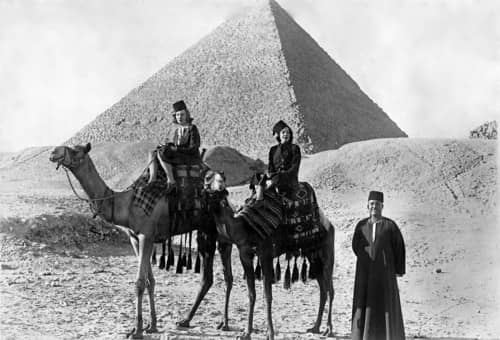
Above: 1938 Dorothy Gray in Egypt. The woman on the front camel is Evelyn Offutt [1918-2012], her niece. Together they toured Egypt and Anglo-Egyptian Sudan, and went on safari in British East Africa (now Kenya).
Dorothy Gray salons
After starting out on 57th Street in 1916, Dorothy Gray moved her New York salon first to 749 and then to 753 Fifth Avenue. By this time she could afford to fit out a salon to rival her old employer. The reception room was decorated with walls of dull silver with wood panelling, doors painted in Russian Green, and with an oriental carpet covering the floor. Furniture was in Louis XVI style upholstered in yellow, rose and blue with the treatment rooms painted in a shade of pink referred to as flesh enamel.
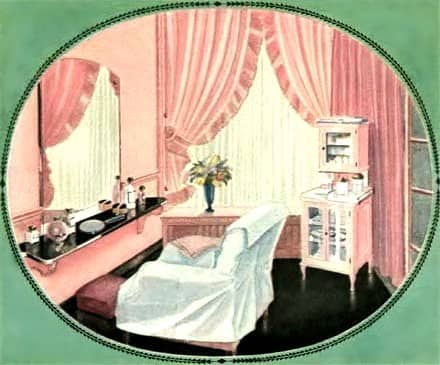
Above: 1928 A treatment room from the Dorothy Gray salon at 753 Fifth Avenue.
Salon treatments
Dorothy Gray described herself as “the daughter of a doctor, scientist and chemist of genius” (Dorothy Gray, 1926, p. 3). However, most of her treatments and products were based on what she had learnt during her time as a treatment girl with Elizabeth Arden. Arden was furious about this having conveniently forgotten that most of her treatments were copied from Eleanor Adair.
See also: Elizabeth Arden and Eleanor Adair
The Dorothy Gray’s list of salon treatments includes most of the standards available at the time.
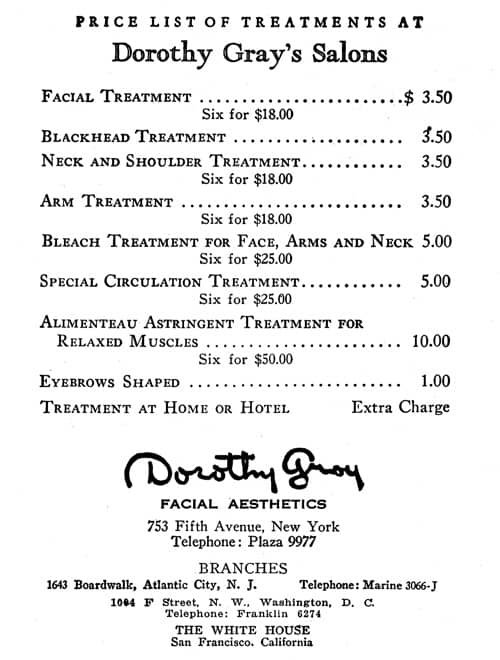
Above: 1926 Dorothy Gray Salon Treatments.
I doubt the above list is complete. There is, for example, no mention of hair removal. Dorothy Gray salon treatments may not have included electrolysis, but she sold two hair removers – Dorothy Gray Wonder Wax and Dorothy Gray Depilatory Powder – and these could have been also used in salon treatments.
The Alimentau Astringent Treatment combined Dorothy Gray Cream Astringent with the yolk of an egg and Dorothy Gray Muscle Oil to form a viscous fluid that was used as a mask. It was removed with cotton pads dipped in Dorothy Gray Orange Flower Water.
Dorothy Gray, after years of study, perfected a facial treatment known as the Alimentau Astringent Treatment. It lifts and tightens the facial muscles and gives new vitality to the tissues by stimulating a healthy circulation and lubricating the skin.
(Dorothy Gray advertisement, 1928)
Skin-care
In the early years, Dorothy Gray’s attention was focussed on mature, female clients who had the time and money to devote to the skin-care treatments and cosmetics available through Dorothy Gray salons.
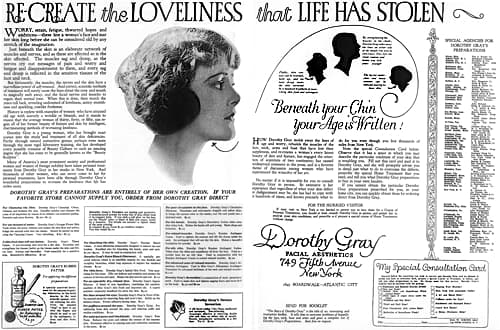
Above: 1924 Recreate the loveliness that life has stolen.
Preparations were available for different skin types along with treatments for all the usual problems – lines and wrinkles, blackheads and enlarged pores, tan and freckles, sallow and flabby skin, and superfluous hair.
Thin and withered faces van be made plump.
Sallow skins can be made white.
The pink glow of youth can be established.
Lines and crow’s feet around the eyes may be corrected.
A reddened nose, large pores or blackheads may be treated successfully.
Too fat chins can be reduced.
Firm muscles indicate youth.
They can be yours!Dorothy Gray, 1926, pp. 11-12)
The home treatments for these ‘areas of concern’ came in plain, boxed kits suitable for posting. The products and routines reputedly following the same steps as the treatments in Dorothy Gray salons. Some early skin-care lines were labelled as ‘Russian’ (e.g., Russian Astringent Cream) but this branding was dropped by the 1930s. Calling her products Russian suggested exotic origins and distinguished them from Elizabeth Arden’s Venetian cosmetics, Arden having selected Venetian to separate her products from the Grecian range she sold when in partnership with Elizabeth Hubbard.
The main principle underlying the Dorothy Gray method for facial skin-care was the need for good skin circulation, one of many ideas she got from Elizabeth Arden.
Dorothy Gray’s method of skin care appeals to the modern woman, for it was evolved with this scientific principle as its foundation: a rapid, healthy circulation is the first essential of a good complexion. Miss Gray’s treatments and preparations cleanse, of course; they nourish the skin; they correct excessive oiliness or dryness. But the basic principle of the Dorothy Gray method is the stimulation of circulation.
(Dorothy Gray advertisement, 1929)
Stimulating skin circulation was combined with cleansing this skin, lubricating, and protecting it from exposure and this formed the basis for all the early Dorothy Gray facial skin-care routines. Massage and other mechanical treatments could be used to stimulate the circulation but Dorothy Gray also sold a Circulation Ointment.
Circulation Ointment: “A fine ointment which stimulates a flow of invigorating circulation, making the skin noticeably clearer and finer after several applications. with its continued use a rapid, healthy circulation will help strengthen relaxed muscles and flabby tissues.”
Circulation Ointment was also used on ‘sallow, lifeless skin’.
Apply it over a thin layer of TISSUE CREAM. Soon your skin will tingle, which means that an invigorating stream of circulation has been stimulated. … When your skin feels glowing, remove the OINTMENT with a bone spatula or the dull edge of a knife. CLEANSING CREAM will remove any surplus ointment.
(Dorothy Gray, 1929, p. 34)
See also: Circulation Creams
Skin types
As previously mentioned, skin-care routines were adjusted for different skin types. In the 1920s, the basic treatment for normal skin was to cleanse with Dorothy Gray Cleansing Cream and then tone with Dorothy Gray Orange Flower Skin Tonic. If the skin was dry, a skin food was then applied, either Dorothy Gray Special Skin Food (later called Special Skin Cream) if the client was thin, Dorothy Gray Tissue Cream if client was plump, as it was considered to be non-fattening, or Dorothy Gray Special Mixture if the skin was sensitive. As oily skin was generally associated with enlarged pores, an astringent that was stronger than Orange Flower Skin Tonic was needed, so Dorothy Gray Pore Lotion and Dorothy Gray Astringent Lotion were used instead and the skin food was skipped.
Cleansing Cream: “Cleans and freshens the skin. Liquefies quickly and cleanses the pores of all impurities by reason of its oiliness—an essential quality,”
Orange Flower Skin Tonic: “Used instead of water; closes the pores, whitens and makes the skin firm. Should be patted on after using the Cleansing Cream.”
Tissue Cream: “A non-fattening skin food for plump face. Nourishes and strengthens the tissues. Softens and beautifies. Use especially for a sensitive skin.”
Special Mixture: “A blend of rare ingredients. … A superb nutrient—especially beneficial for extra dry skin.”
Special Skin Food: “Very nourishing for thin faces and throats.”
Pore Lotion: “Helps reduce enlarged pores and corrects the shine of an oily skin. It has excellent stimulating and cooling effect and tends to keep the skin fine in texture.”
Russian Astringent Lotion: “Generally used before the Russian Astringent Cream, with which it is to be used in conjunction. Helps make relaxed muscles firm, and to contract loose and flabby skin.”
See also: Skin Foods and Skin Tonics, Astringents and Toners
Clients were advised against using soap and water on the face as ‘water does not cleanse the face properly, and soap contains lye and other deleterious ingredients, which in time injures delicate skin’.
Special problems
Treatments for double chins and crêpy throats figured strongly in Dorothy Gray advertisements as visible signs of ageing. Double chins were treated with Dorothy Gray Astringent Lotion and Dorothy Gray Astringent Cream combined with the use of the Dorothy Gray Patter, Dorothy Gray Tonic Patter and/or a Dorothy Gray Chin Strap. Crêpy throats required Dorothy Gray Circulation Ointment and Special Skin Cream, Tissue Cream or Special Mixture applied with the Dorothy Gray Patter.
The use of patters and straps were two treatment practices Dorothy Gray also got from Elizabeth Arden and, like Arden, Dorothy Gray does not appear to have been in favour of steaming as it could make the skin lax.
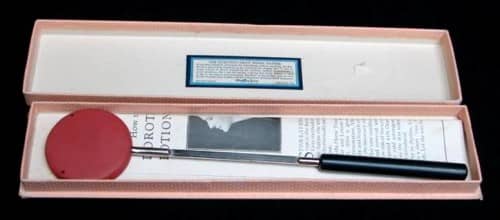
Above: Dorothy Gray Patter. If the face was thin the Patter was to be used gently, if plump, firmly.
Dorothy Gray Patter: “A perfect aid to the application of the creams. Stimulates the circulation, thus restoring firmness to sagging muscles and drooping facial contour, and color to sallow skins. Gives the smart, firm sting so hard to get with the fingers. Easily sterilised.”
Dorothy Gray Tonic Patter: “Made on the same lines as the Patter, but with a hollow side which can be packed with cotton saturated with Orange Flower Skin Tonic or Pore Lotion.”
Dorothy Gray Chin Strap: “An elastic rubber strap which helps reduce a too full underchin. Fits snuggly and comfortably over the head. To be worn a few hours a day. These can not be returned or exchanged. Two sizes, large and small.”
One-two-three
One-two-three
One-two-three
Beats the little Dorothy Gray Patter rhythmically, as it quickens the circulation into healthy activity. It is rapid circulation which helps keep the facial muscles active, the tissues firm. Dorothy Gray’s method of stimulation is vigorous enough to benefit the muscles and tissues, gentle enough to leave unharmed the network of tiny blood vessels which lie beneath the skin. The Dorothy Gray Patter is designed to give the needed sting so difficult to achieve with the fingers.
Pat in a nourishing cream – Dorothy Gray’s Special mixture for dry and sensitive skin, her Tissue Cream for plump faces, her Special Skin Food for thin ones.(Dorothy Gray advertisement, 1928)
See also: Patters and Straps, Bandages and Tapes
For lines and wrinkles there was Dorothy Gray Muscle Oil, used in isolation or mixed in with a skin cream. Like other muscles oils sold at the time it was supposed to nourish the muscles making them full and firm once more. This strengthened the underlying tissues and reduced wrinkling.
Muscle Oil: “A fine penetrating oil for strengthening relaxed tissues.”
See also: Muscle Oils
Enlarged and blocked pores were major considerations for Beauty Consultants before the Second World War. Pores were considered to be openings through which the skin breathed and were also channels for skin foods. Enlarged pores and blackheads were therefore regarded as visible symptoms of skin malfunction.
See also: Enlarged Pores
Blackheads and enlarged pores were treated by thoroughly cleansing the skin with Dorothy Gray Cleansing Cream followed by Orange Flower Skin Tonic. Dorothy Gray Pore Paste was then applied to be left on overnight. This medicated paste was said to normalise the pores after any blackheads had been pressed out. More severe problems could be treated with Dorothy Gray Acne Lotion.
Pore Paste: “A medicated night cream for treating blackheads and enlarged pores. To be applied after the skin has been cleansed and the blackheads pressed out, to contract the pores. It has antiseptic and soothing qualities.”
Acne Lotion: “Relieves acne, eruptions and irritated skin.”
Dorothy Gray sold skin bleaches in two strengths to remove tan, freckles and other blemishes, the milder Russian Bleach Cream and a stronger Extra Bleach Ointment.
Russian Bleach Cream: “A preparation designed to remove tan, freckles and blemishes of less stubborn character and more recent origin. May be used in conjunction with Extra Bleach Ointment. Excellent for bleaching the hands.”
Extra Bleach Ointment: “A specially prepared mixture for tan, freckles and unsightly blemishes, which long exposure or neglect has rendered chronic.”
Other body treatments included Dorothy Gray Remoldine for flabby busts; Dorothy Gray Depilatory Powder and Dorothy Gray Wonder Wax for removing superfluous hair; Dorothy Gray Reducing Cream (1920) for locally reducing flesh; and Dorothy Gray Strawberry Hand Lotion to whiten and soften the hands.
Eyes
Dorothy Gray sold a range of eye preparations to counteract tired eyes, reduce puffiness, and help lashes grow.
Pour la Pattie d’Oie: “An unusual paste for strengthening the tissues aboyt the eyes. Firmly adhesive during sleep.”
Eylac: “Tightens skin around the eyes and reduces puffy condition.”
Eye Lotion: “A tonic and wash from the prescription of a renowned European eye specialist. Wonderfully refreshing and strengthening for tired eyes.”
Eye Drops: “Strengthens the eyes and gives a brilliant lustre. Especially for use in the evening. Relieves eye irritation.”
Eyebrow and Eyelash Grower: “Stimulates the activity of the hair follicles, and helps the brows to grow thick, and lashes long and curly, adding greatly to the charm of the eyes.”
Make-up
Along with skin-care products, Dorothy Gray also sold a range of decorative cosmetics, such as powder, rouge, lipstick, mascara, eyeliner and eye-shadow; toiletries such as bath salts and soaps; and manicure equipment and nail polishes. Vanity cases, compacts and perfumes were also available for purchase.
Until the 1920s, Dorothy Gray make-up came in a limited range of colours that were mostly selected by hair and skin colour. Like other cosmetic companies of the time, powder colours came in shades like Natural, Flesh, Peach, White, and Rache until the rise of suntanning in the 1920s saw a move towards darker tones. Some allowance was made for the standard hair colourings like brunette, medium, and blonde but, in general, there was little colour choice available when selecting a rouge, lipstick, eyeshadow, mascara or eyeliner.
Foundation
As far as I can tell, Dorothy Gray never sold a product labelled as a vanishing cream. Her face powders were described as ‘clinging’ but if needed, women could use Dorothy Gray Russian Astringent Cream as a powder base. However, it was described as ‘greaseless’; i.e., it was not a cold cream, so was probably a type of vanishing cream. Women who thought it was to think for their requirements could dilute it with Orange Flower Water. Those with an oily skin could switch to the previously mentioned Dorothy Gray Russian Astringent Lotion.
Astringent Cream: “An unequalled powder base. A greaseless cream, with delightful astringent qualities, which imparts a silken finish to the skin. … Patted on dry skins before exposure to the wind and sun, it helps protect against freckles, sunburn and tan.”
Face powders
In 1926, Dorothy Gray was making loose face powders in three main forms – Day Powder, Jacqueminot Powder and Extra Heavy Powder.
Day Powder: “A fine, dry, moisture proof powder which adheres perfectly.“ Shades: White, Flesh, Peach, Rachel, Natural and Cream. Additional shades: Peach Aureate (later called Aureate) replacing Peach (1927); Burnt Aureate and Sunburn added by 1929; and Copper (1930).
Jacqueminot Powder: “An extra-fine, invisible face powder.“ Shades: White, Flesh, Peach, Rachel, Cream, Natural and Violet. Additional shades: Peach Aureate (1927); Burnt Aureate, and Sunburn added by 1929; and Copper (1930).
Extra Heavy Powder: “A finely adherent especially heavy face powder.” Shades: White, Flesh, Peach, Rachel, Cream, Natural and Violet. Additional shades: Peach Aureate, and Burnt Aureate (1927); Tawny Rachel, and Sunburn added by 1929; and Copper, and Orchid (1930).
Like Elizabeth Arden, Dorothy Gray also sold the odd face powder based on a single shade, the Burnt Aureate Face Powder, introduced in 1921, being a good example. There is also evidence that Dorothy Gray supplemented the shade ranges of her face powders with a Powder Blending Service offered through her salons. I have been unable to find any information on this service but presumably it would have enabled Dorothy Gray to more closely match her powder shades to a client’s individual complexion.
Lipstick and rouge
In addition to a Lip Stick in Brunette, Medium, and Blonde tints, Dorothy Gray also sold a Special Lip Rouge, a cream that also helped prevent lip dryness, in Light, Medium and Dark shades. By 1929, Dorothy Gray Lipsticks shades had been renamed as Light, Medium, and Dark to bring them in line with other Dorothy Gray lip make-ups and rouges and a new vivid shade had been added for use at night, suitably called Evening.
Dorothy Gray Rouge came in three forms: Dorothy Gray Cherri Rouge, a liquid rouge in Light, Medium, and Dark shades; Dorothy Gray Tangerine Rouge, a changeable cream rouge made with eosin that went from orange to pink on the cheeks; and Dorothy Gray Compact Rouge in Medium, Dark, Tangerine, and Avis shades. The Avis shade was named after Dorothy Gray’s younger sister, Avis Cloudman. By 1929, the Compact Rouge was produced in Avis, Sunset, Rouge d’Espagne, and Medium shades with Tawny added in 1930.
Dorothy Gray did not make a cosmetic specifically designated as a cream rouge in the 1920s. However, Dorothy Gray Tangerine Rouge could be thought of as a cream rouge and it is possible that some women also used Dorothy Gray Special Lip Rouge on their cheeks as well as their lips.
Eye make-up
By 1926, Dorothy Gray had all the main forms of eye make-up in place including: Eye Shadow in Blue, Gray, and Brown shades with Black added by 1929; Lashique, a cake/block mascara in Brown, and Black, with Light Brown added by 1929, and Blue in 1930; and Eyebrow Pencils in Golden-Brown, Dark-Brown, and Tan, becoming Light Brown, Brown, Black, and Blue by 1929. Liquid Lashique, a waterproof liquid mascara was added in 1930.
Also see the booklet: The Story of Dorothy Gray (1926)
Lehn & Fink
In 1927, Dorothy Gray was bought by Lehn & Fink, a New York based pharmaceutical company. Established in 1874, Lehn & Fink was mainly known for household products such as Lysol disinfectant and Pebeco toothpaste and powder. In 1925, a review of Lehn & Fink’s business revealed that its wholesale drug business was not as profitable as its proprietary lines and the company then began acquiring established cosmetic and toiletries brands starting with the A. S. Hinds Company in 1925. After their purchase of Dorothy Gray in 1927, they went on to acquire Lesquendieu in 1929 and The Ogilvie Sisters in 1956.
See also: Lehn & Fink
When purchased by Lehn & Fink, Dorothy Gray had sales of less than half-a-million dollars but was making a good profit. The chemist Michael J. Gregory continued to direct production and Helen Martin, formerly of the J. Walter Thompson advertising agency, was put in charge of the day-to-day management of the business. Lehn & Fink also appointed Lowell Fess [1895-1971], the son of Senator Fess of Ohio, as the sales manager of Dorothy Gray. He embarked on a campaign to increase sales partly by expanding the number of Dorothy Gray salons both within the United States and overseas. Beginning with Los Angeles and Chicago in 1927, American salons were then added in places such as Denver, Boston, Milwaukee, Norfolk, Seattle, and Buffalo.
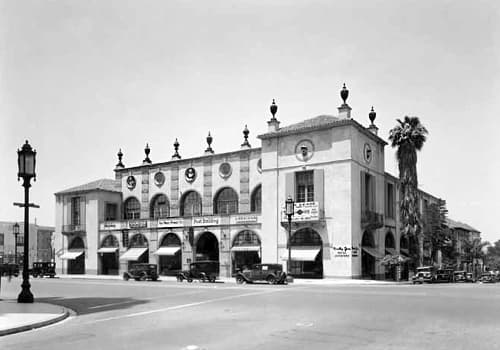
Above: c.1930 Dorothy Gray salon in the Post Office Building on the corner of Wilshire Boulevard and Berendo Street, Los Angeles.
In 1929, the company also opened a flagship shop, salon and executive offices in the new Dorothy Gray Building at 683 Fifth Avenue, New York.
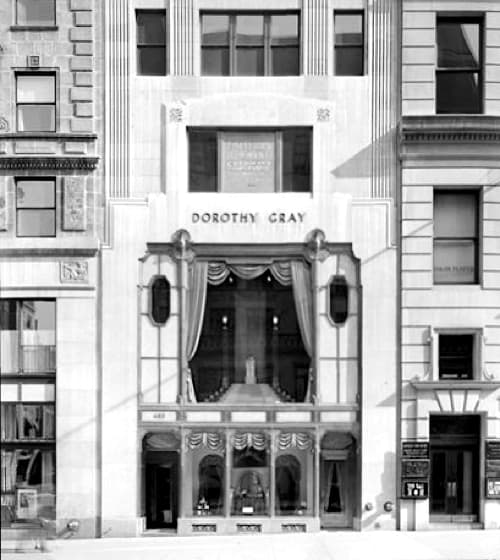
Above: 1929 Entrance to the Dorothy Gray Salon.

Above: 1929 The first floor of the Dorothy Gray salon at 683 Fifth Avenue, New York. Armchairs allowed clients to wait for an attendant to provide them with advice, determine skin type and tone, or select products in one of two ‘analysis rooms’. Walking through the corridor lined with tall dressing cases, from which products could be viewed and selected, you reached a long staircase that took you to the salon on the second floor. There you entered a vestibule decorated in French First Empire style, with a high dome ceiling and plush carpet, containing a central oval shape reception desk surrounded by couches placed against the walls. Glass fronted cabinets containing Dorothy Gray products were built into the walls.
Women booked in for a facial were ushered into a room where they settled into a big, deep, covered armchair with an additional block to raise the legs. They faced a large, shelved mirror and there was a small medicinal looking cabinet to one side which held a range of products.
Repackaging
In 1926, the Armand Company won a court case establishing its right for sole use of the ‘Hoop Skirt Girl’ as its trademark. This forced both Tre-Jur and Dorothy Gray to stop using images of a girl in a hoop skirt in their advertising and packaging. Tre-Jur adopted the upper part of its old trademark thus getting rid of the hoop skirt but Dorothy Gray did a complete redesign which debuted in 1928.

Above: c.1924 Dorothy Gray packaging with hoop skirt figure disallowed after the 1926 Armand court case.
The new Dorothy Gray packaging used blue as its primary colour and replaced the image of the hoop skirt girl a classically inspired, seated figure of a woman. The redesign complemented the neoclassical French First Empire style used to decorate the new Dorothy Gray salon in New York. Images from the Paris salon suggest that treatment girls were also dressed ‘neoclassically’, wearing uniforms inspired by the Ionic Chiton worn by women in classical Greece.
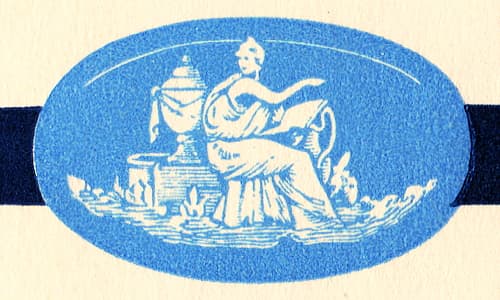
Above: Dorothy Gray seated figure.
Products
Dorothy Gray treatments after the buyout by Lehn & Fink continued to stress the need to improve skin circulation and the three-step skin-care process &nhash; cleansing, stimulating and lubricating – with adjustments for different skin types. As before, products and treatments were designed to help avert the three visible signs of ageing that occurred at the eyes, chin and throat.
Age first shows in these three places: in the texture of the throat, in the under-chin line and in lines and wrinkles about the mouth and eyes. My years of experience in treating thousands of women taught me this and guided me in evolving corrective treatments for these conditions. The velvet-smooth skin of a young person withers without proper cleansing, lubrication, and that basic essential—a healthy stream of circulation, which gives vitality to every tiny blood vessel.
A rapid, healthy circulation is of primary importance in keeping the facial muscles strong and taut, and in maintaining the firm skin tension of youth. When the circulation grows sluggish, the muscles will relax so that the tissues inevitably weaken and grow flabby, and the skin stretches and sags in unsightly wrinkles. Without this vital circulation, without proper cleansing and lubrication, the skin of the face is lined by each passing day, the contour muscles become flaccid and the chin line coarsens and droops in ugly heaviness.(Dorothy Gray, 1929, p. 25)
Also see the booklet: Your Dowry of Beauty (1929)
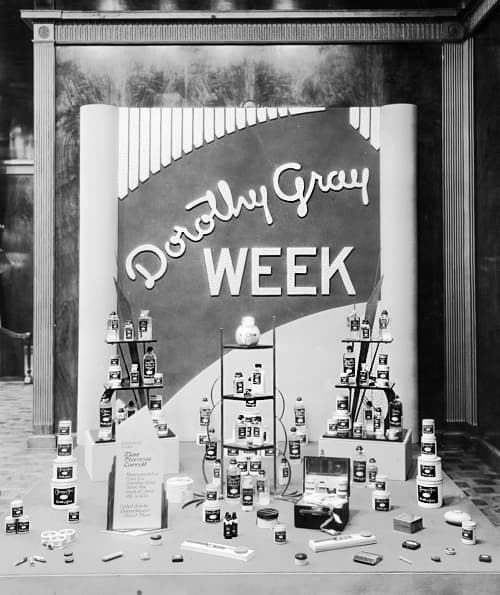
Above: 1930 Floor display of Dorothy Gray products in a department store in Oklahoma cCity.
Changes made to the Dorothy Gray product range through to 1930 included the sensible renaming of Pour La Patte d’Ole as Eye Muscle Paste, and Cherri Rouge as Liquid Rouge. In addition, all references to products being Russian were removed. There are also suggestions that Lehn & Fink also discontinued the Dorothy Gray Nail Polish (Powder) and the Chan Wah Poli nail polish.
In 1928 the new management combined a liquid soap, a sulphur lotion and an emollient cream into the Dorothy Gray Acne Set. The sulphur lotion was probably the Dorothy Gray Sulphur Lotion, introduced in 1921. Going on images, the Emollient Cream looks to have been a lotion so it may have been a medicated version of the Dorothy Gray Texture Lotion that debuted in 1929.
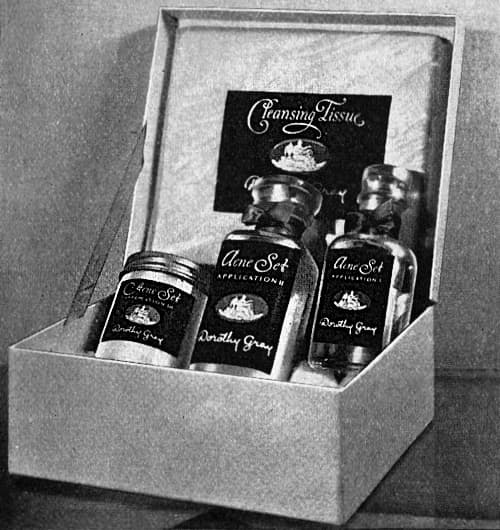
Above: 1929 Dorothy Gray Acne Set. From left to right: Emollient Cream, Sulphur Lotion and Liquid Soap.
My ACNE SET is in three units. The first is an ethereal sop solution which should be applied to the face, and worked up into a later with the aid of warm water. This lather should be thoroughly worked into the pores, then the face should be rinsed with warm water and dried carefully. The next step is the application of the special sulphur solution. Shake this up well and apply it to the face with a piece of absorbent cotton. Always allow tit to dry and remain on the face overnight. In the morning, the third unit, the emollient cream, should be patted gently into the face until it is well absorbed.
(Dorothy Gray, 1929, pp. 34-35)
Acne Set: “An extremely effective treatment for acne, made from the formula of a famous dermatologist. A scientific, simple method for home use which gives remarkably successful results.”
Texture Lotion: “Use it first thing in the morning to cleanse your skin, to wake it up, and to close the pores. And whenever you have used Cleansing Cream, follow with Texture Lotion. It will remove the last traces of the cream—leaving your skin gloriously cool and fresh. Texture Lotion by itself is perfect for cleansing the skin in the morning, or whenever there is no make-up. It checks an oily skin condition, and its continued use will reduce enlarged pores.”
Outdoor pursuits
The first quarter of the twentieth century saw women take a greater interest in sports and other outdoor activities such as sunbathing, then also known as sunburning. Towards the end of the 1920s, Dorothy Gray developed a number of products that catered for the more active woman and/or fashion trends that increasingly exposed more skin to the elements.
Dorothy Gray Finishing Lotion (1929), which came in a range of shades, evened out skin tones on arms and legs exposed to the sun. It seems to have been an updated version of the earlier Dorothy Gray Enameline – a liquid powder in Natural, Flesh, Peach, and White shades – the inclusion of darker shades being a reflection of the popularity suntanning had achieved by the late 1920s.
See also: Liquid Face Powders
Dorothy Gray Sunburn Cream could be used for those who wished to avoid a tan altogether. Although less effective than modern formulations, it contained the ultra-violet (U.V.) chemical filters benzyl salicylate and benzyl cinnamate in a formulation developed for Lehn & Fink by Dr. Emil G. Klarmann [1900-1963] in 1928, making it the first of its type.
Other new cosmetics that had sunshine in mind were Dorothy Gray Coppertan, an artificial tan, and Finishing Lotion, a liquid powder for the back, shoulders, arms and legs to be used in the evening, on the beach or when playing sports. Both products were released in 1929. Like Coppertan, Finishing Lotion and the new darker shades of face powder were needed for suntanned skin.
Sunburn Cream: “A flower-scented cream of milky consistency which prevents sunburn but permits the skin to tan.”
Coppertan: “To create an artificial tan. A delicately scented creamy liquid which smooths in quickly and evenly.”
Finishing Lotion: “This miraculous lotion makes your arms and shoulders look smooth as flawless velvet—and it doesn’t rub off on your partner’s coat or on your frock!” Shades: Blonde, Natural, Rachel, Aureate, Orchid, Sunburn, and Tawny.
Timeline
| 1916 | New York studio salon opened at 2 West 57th Street, New York. |
| n.d. | Salon relocates to 749 5th Avenue, New York. |
| 1919 | New Products: Dandruff Ointment. |
| 1920 | New Products: Reducing Cream. |
| 1921 | New Products: Talcum Powder; Sulphur Lotion; Reducing Salts; and Bath Crystals. |
| 1922 | Laboratory established at 142, 59th Street, New York, in charge of Michael J. Gregory. |
| 1923 | New York salon moves to 116 East 59th Street. |
| 1924 | New York salon moves to 753 5th Avenue, New York. |
| 1926 | Salon opened in San Francisco. |
| 1927 | Dorothy Gray acquired by Lehn & Fink. Dorothy Gray incorporates in New Jersey. Salons opened in Chicago and Los Angeles. |
| 1928 | Dorothy Gray building erected in New York. New Products: Texture Lotion; Sunburn Cream; and Acne Set. |
| 1929 | Salon opens in the new Dorothy Gray building. Packaging updated. Radio broadcasting begins. New Products: Finishing Lotion. |
| 1930 | Paris salon opened at 34 Avenue George V. New Products: Skyscraper Compact; Cream Rouge; and Liquid Lashique. |
Continued onto: Dorothy Gray (1930-1945)
First Posted: 14th October 2010
Last Update: 8th October 2022
Sources
Dorothy Gray. (1926). The Dorothy Gray story [Booklet]. U.S.A.: Author.
Dorothy Gray. (1929). Your dowry of beauty [Booklet]. U.S.A.: Author.
Peiss, K. (2007). Hope in a jar: The making of America’s beauty culture. New York: Henry Holt and Company.
Woodhead, L. (2003). War paint: Miss Elizabeth Arden and Madame Helena Rubinstein. Their lives, their times, their rivalry. London: Virago.
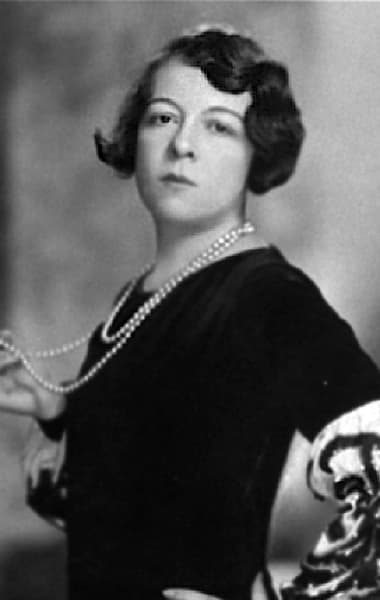
Dorothy Gray [1886-1968], a.k.a. Dorothy Cloudman.

1921 Dorothy Gray Russian Bleach Cream and Extra Bleach Ointment.

1921 Dorothy Gray Burnt Aureate.
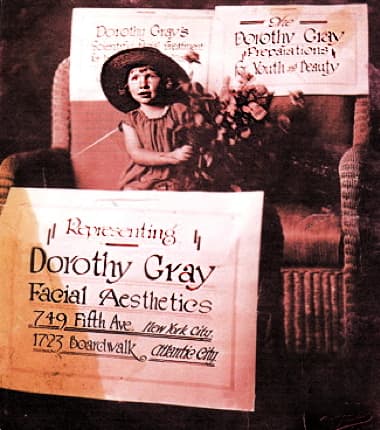
c.1922 Dorothy Gray. Hand-drawn advertising as the business was getting started. The child in the image is Dorothy Gray’s niece, Evelyn Offutt.
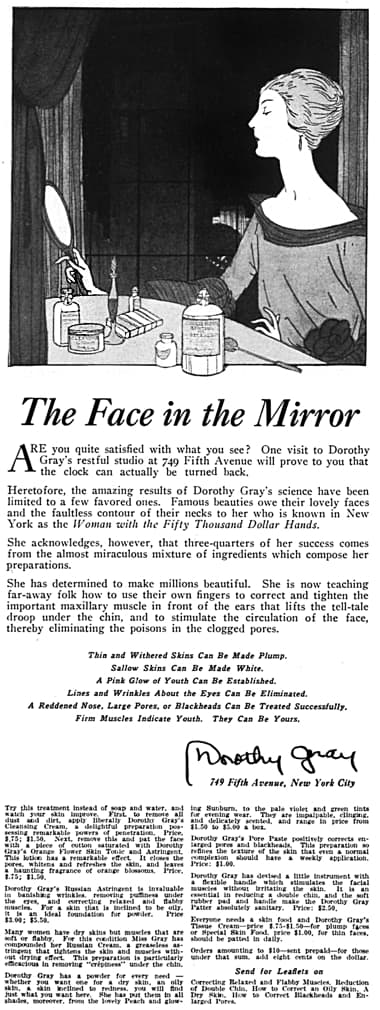
1922 Dorothy Gray.
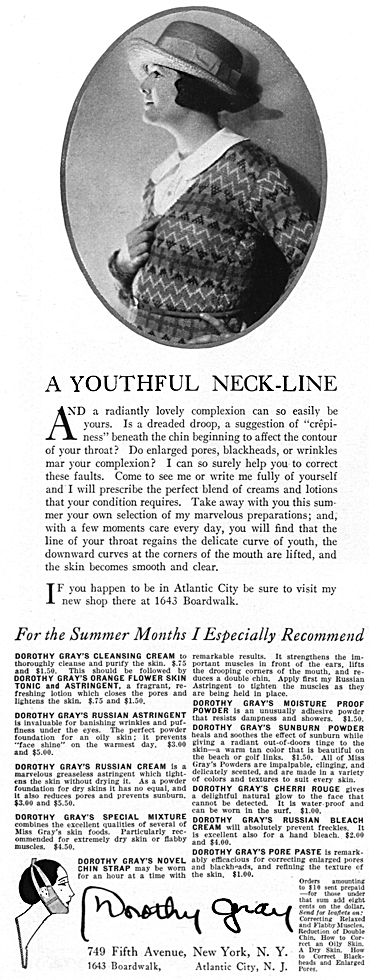
1922 Dorothy Gray Youthful Neckline.

1923 Dorothy Gray throat treatments.
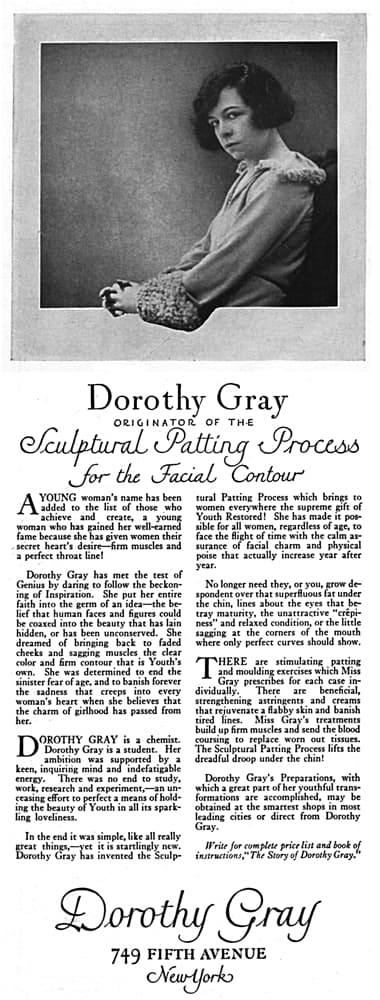
1923 Dorothy Gray Sculptural Patting Process.
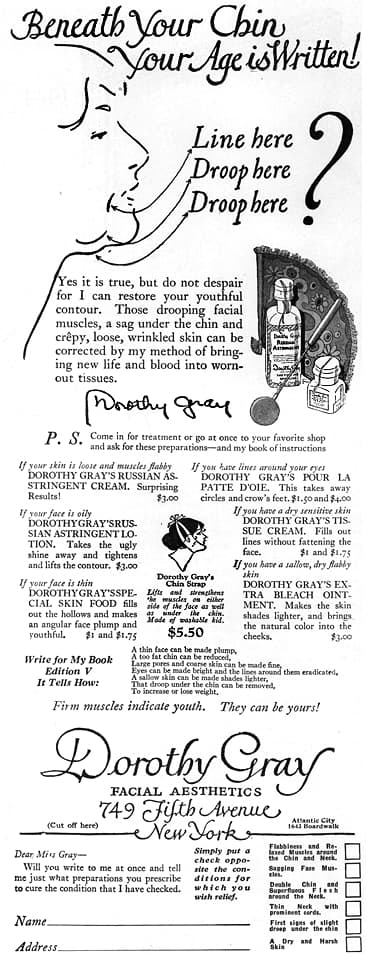
1924 Beneath your chin your age is written.
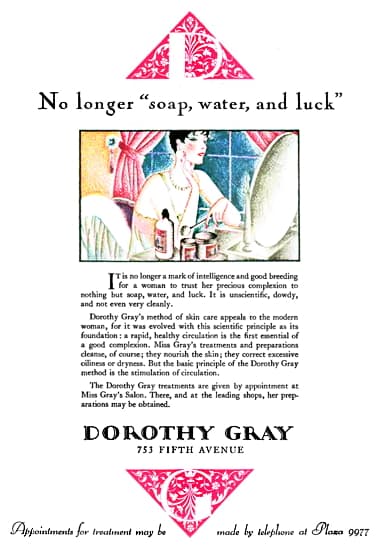
1926 Dorothy Gray.
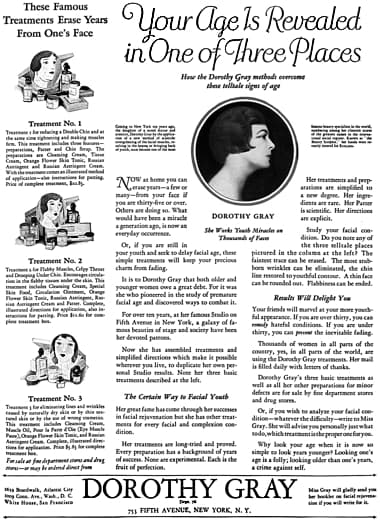
1926 Your age is revealed in one of three places.
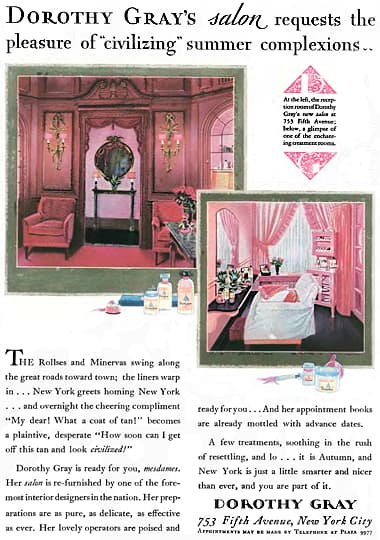
1927 Dorothy Gray New York Salon at 753 5th Avenue.
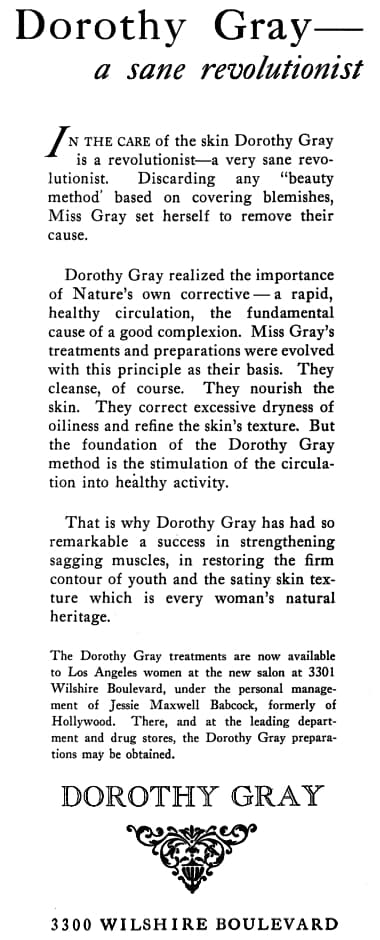
1927 Dorothy Gray Los Angeles.
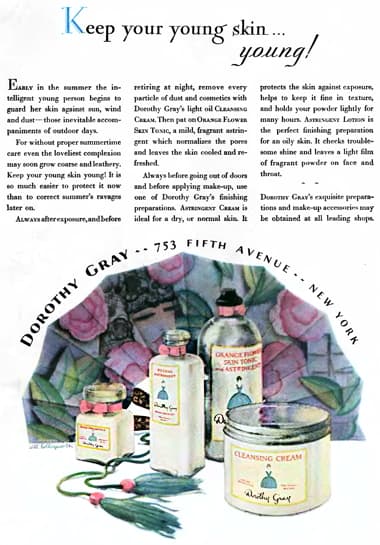
1928 Dorothy Gray products in packaging that conflicted with Armand. Pink ribbon was used, a feature that mimicked Elizabeth Arden products.
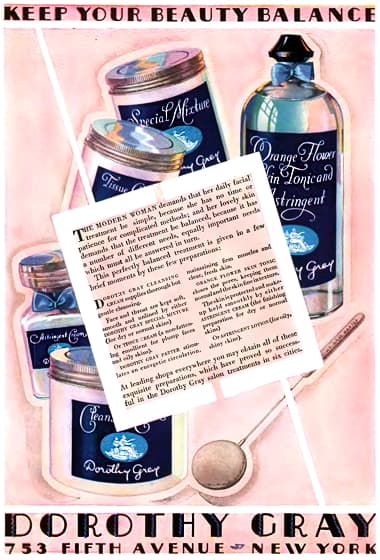
1928 Dorothy Gray products in new packaging introduced by Lehn & Fink. now using blue ribbon.
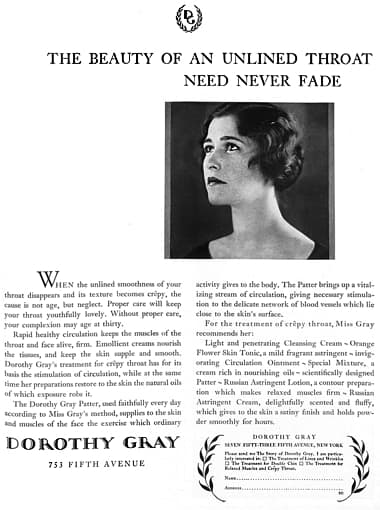
1928 Dorothy Gray crêpy throat treatments.
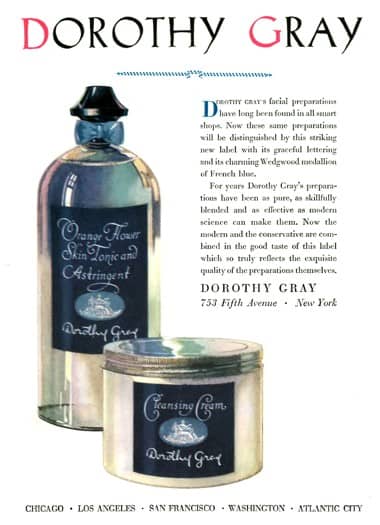
1928 Dorothy Gray Orange Water Skin Tonic and Astringent and Cleansing Cream.
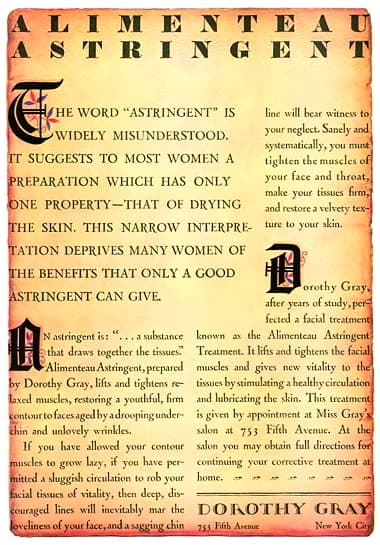
1928 Dorothy Gray Alimenteau Astringent.

1928 Dorothy Gray compacts and lipsticks.
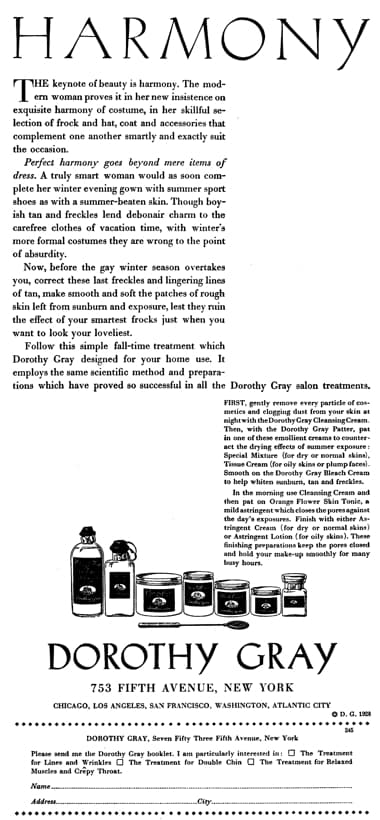
1928 Dorothy Gray.
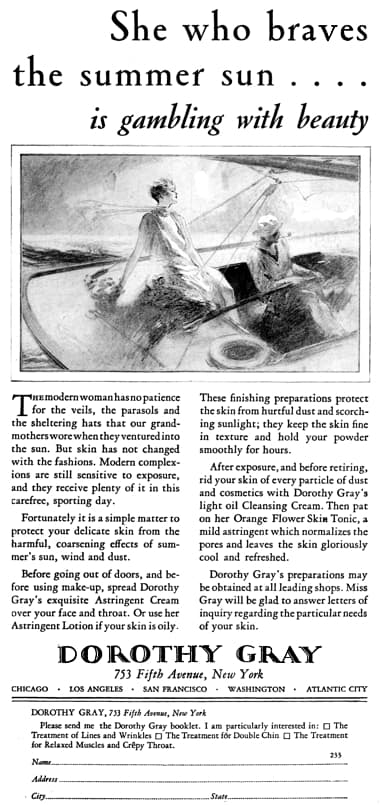
1928 Dorothy Gray summer sun-care.
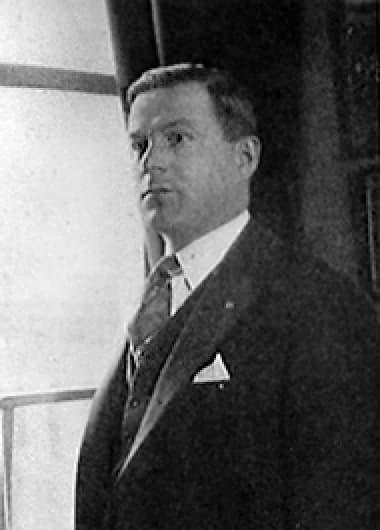
1929 Lowell Fess, appointed the Sales Manager for Dorothy Gray by Lehn & Fink.
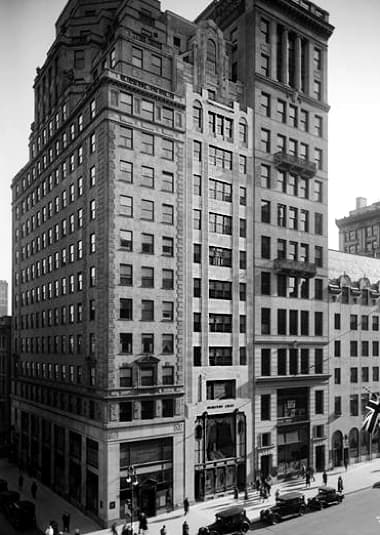
1929 The 12-story Dorothy Gray Building at 683 Fifth Avenue – it is the middle of the three tall buildings in the photograph. Designed by the architects Robert David Kohn [1870-1953] and Charles Butler [1870-1953], it received a silver medal from the Fifth Avenue Association in 1929. The Dorothy Gray salon occupied the second floor while the executive offices were on the 10th, 11th, and 12th floors and the lower floor of the penthouse. The fact that her former employee now had a building named after her must have really irked Elizabeth Arden.
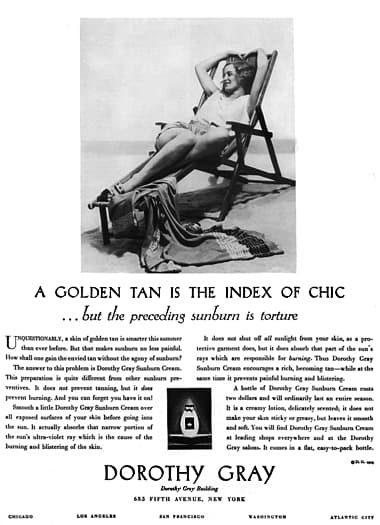
1929 Dorothy Gray Sunburn Cream.

1929 Announcement of the opening of the new salon in the Dorothy Gray Building. Note the mention of the powder blending service.
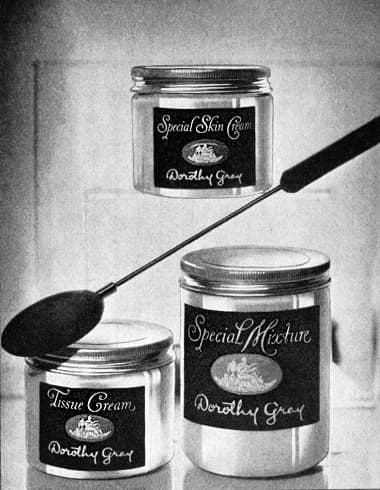
1929 Special Skin Food, Tissue Cream, Special Mixture and the Dorothy Gray Patter.
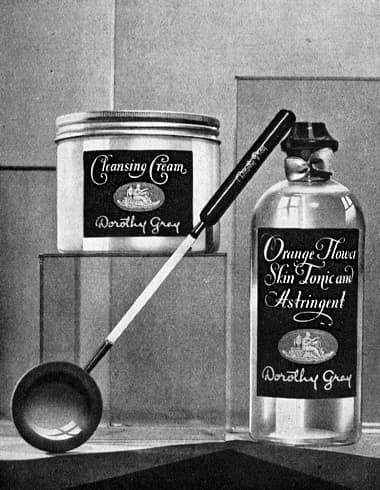
1929 Cleansing Cream, and Orange Flower Skin Tonic and Astringent and the Dorothy Gray Tonic Patter. This patter had a hollow surface on one side that could be packed with cotton wool soaked with Orange Flower Skin Tonic and Astringent.
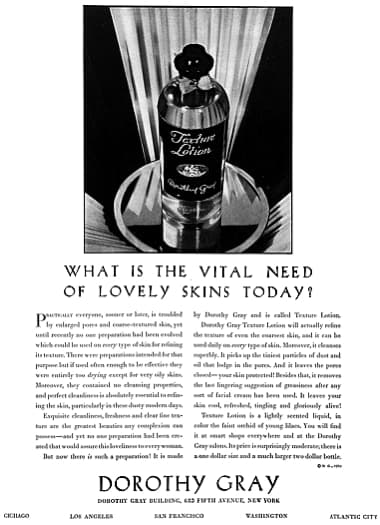
1929 Dorothy Gray Texture Lotion.
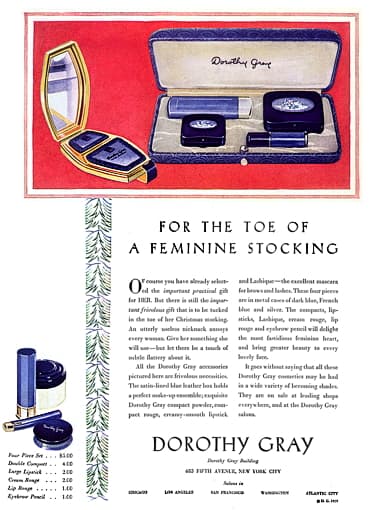
1929 Dorothy Gray cosmetics.

1929 Dorothy Gray double chins.
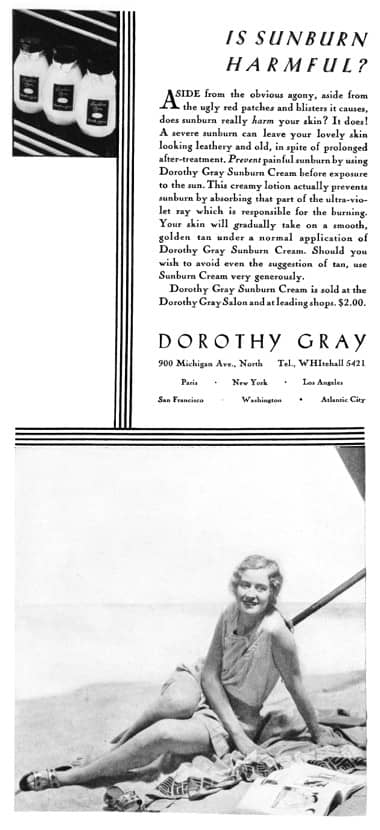
1930 Dorothy Gray Sunburn Cream.
